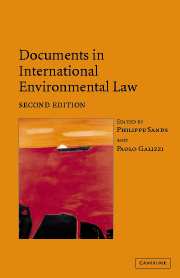Book contents
- Frontmatter
- Contents
- Preface
- PART I General instruments
- PART II Atmosphere
- PART III Oceans: global
- PART IIIB Oceans: regional
- PART IV Freshwater resources
- PART V Biodiversity
- 16 International Convention for the Regulation of Whaling, 2 December 1946
- 17 Convention on Wetlands of International Importance Especially as Waterfowl Habitat, 2 February 1971
- 18 Convention Concerning the Protection of the World Cultural and Natural Heritage, 16 November 1972
- 19 Convention on International Trade in Endangered Species of Wild Fauna and Flora, 3 March 1973
- 20 Convention on the Conservation of Migratory Species of Wild Animals, 23 June 1979
- 21 Convention on Biological Diversity, 5 June 1992
- 21A Cartagena Protocol on Biosafety to the Convention on Biological Diversity, 29 January 2000
- 22 Non-Legally Binding Authoritative Statement of Principles for a Global Consensus on the Management, Conservation and Sustainable Development of All Types of Forests, 13 June 1992
- 23 United Nations Convention to Combat Desertification in Countries Experiencing Serious Drought and/or Desertification, Particularly in Africa, 17 June 1994
- PART VIA Hazardous substances and activities: nuclear
- PART VIB Hazardous substances and activities: pesticides
- PART VIC Hazardous substances and activities: waste
- PART VII Human rights and the environment
- PART VIII War and the environment
- PART IX Trade and the environment
- PART X Environmental impact assessment and access to information
- PART XI Liability for environmental damage and breaches of environmental obligations
- PART XII The Antarctic
18 - Convention Concerning the Protection of the World Cultural and Natural Heritage, 16 November 1972
Published online by Cambridge University Press: 05 June 2012
- Frontmatter
- Contents
- Preface
- PART I General instruments
- PART II Atmosphere
- PART III Oceans: global
- PART IIIB Oceans: regional
- PART IV Freshwater resources
- PART V Biodiversity
- 16 International Convention for the Regulation of Whaling, 2 December 1946
- 17 Convention on Wetlands of International Importance Especially as Waterfowl Habitat, 2 February 1971
- 18 Convention Concerning the Protection of the World Cultural and Natural Heritage, 16 November 1972
- 19 Convention on International Trade in Endangered Species of Wild Fauna and Flora, 3 March 1973
- 20 Convention on the Conservation of Migratory Species of Wild Animals, 23 June 1979
- 21 Convention on Biological Diversity, 5 June 1992
- 21A Cartagena Protocol on Biosafety to the Convention on Biological Diversity, 29 January 2000
- 22 Non-Legally Binding Authoritative Statement of Principles for a Global Consensus on the Management, Conservation and Sustainable Development of All Types of Forests, 13 June 1992
- 23 United Nations Convention to Combat Desertification in Countries Experiencing Serious Drought and/or Desertification, Particularly in Africa, 17 June 1994
- PART VIA Hazardous substances and activities: nuclear
- PART VIB Hazardous substances and activities: pesticides
- PART VIC Hazardous substances and activities: waste
- PART VII Human rights and the environment
- PART VIII War and the environment
- PART IX Trade and the environment
- PART X Environmental impact assessment and access to information
- PART XI Liability for environmental damage and breaches of environmental obligations
- PART XII The Antarctic
Summary
Editorial note
The Convention for the Protection of the World Cultural and Natural Heritage was adopted under the auspices of UNESCO. It applies to ‘cultural heritage’ and ‘natural heritage’ which is of ‘outstanding universal value’ from several points of view (Articles 1 and 2), as defined by reference to, inter alia, conservation (Article 2). The Convention places the primary duty upon each State Party to ‘do all it can’ to identify, protect, present and transmit the natural and cultural heritage to future generations (Article 4). Each Party is required to endeavour to include in its planning the protection of their cultural and natural heritage and to take appropriate measures to protect, conserve and rehabilitate this heritage (Article 5). The Convention further places on the international community as a whole the duty to co-operate in the protection of such heritage, and, accordingly, Parties undertake to provide assistance in the identification, protection, conservation and preservation of cultural and natural heritage when so requested (Article 6).
The Convention establishes a World Heritage Committee within UNESCO, composed of a limited number of experts elected by the Parties meeting in General Assembly (Article 8). On the basis of information submitted by Parties, the definitions of cultural and natural heritage and its own criteria, the Committee is to establish two lists: the World Heritage List and the List of World Heritage in Danger (Article 11). The Committee receives requests for international assistance from Parties for the protection, conservation, presentation or rehabilitation of their cultural and natural heritage, and decides on how the World Heritage Fund is to disburse funds (Article 13).
- Type
- Chapter
- Information
- Documents in International Environmental Law , pp. 644 - 660Publisher: Cambridge University PressPrint publication year: 2004
- 1
- Cited by



